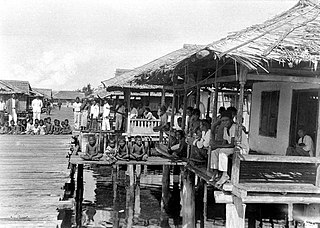
Buginese or Bugis is a language spoken by about 4 million people mainly in the southern part of Sulawesi, Indonesia.

South Sulawesi is a province in the southern peninsula of Sulawesi, Indonesia. The Selayar Islands archipelago to the south of Sulawesi is also part of the province. The capital and largest city is Makassar. The province is bordered by Central Sulawesi and West Sulawesi to the north, the Gulf of Bone and Southeast Sulawesi to the east, Makassar Strait to the west, and Flores Sea to the south.

The Bugis people, also known as Buginese, are an Austronesian ethnic group—the most numerous of the three major linguistic and ethnic groups of South Sulawesi, in the south-western province of Sulawesi, third-largest island of Indonesia. The Bugis in 1605 converted to Islam from Animism. Although the majority of Bugis are Muslim, a small minority adhere to Christianity as well as a pre-Islamic indigenous belief called Tolotang.

Kallang is a planning area and residential zone located in the Central Region of Singapore.

Malay Singaporeans are Singaporeans of Malay ancestry, including those from the Malay Archipelago. They constitute approximately 13.5% of the country's residents, making them the second largest ethnic group in Singapore. Under the Constitution of Singapore, they are recognised by the government as the indigenous people of the country, with Malay as the national language of Singapore.

The Bajo, Bajonese, Bajonesian, or Wajo, Wajonese are the indigenous Indonesian ethnic group native to the Bajo Island of Lesser Sunda Islands in Indonesia. These ethnic group can be found all across the Flores Sea to the northeastern Bali Sea, and some have established permanent settlements in the southern of Sulawesi where they are locally known as the Wajo Bugis due to their close historical relation with the Bugis ethnic group.

Bugis is an area in Singapore that covers Bugis Street, now located within the Bugis Junction shopping mall. Bugis Street was renowned internationally from the 1950s to the 1980s for its nightly gathering of transvestites and transsexuals, a phenomenon which made it one of Singapore's most notable attractions for foreign visitors at the time.
The Lontara script, also known as the Bugis script, Bugis-Makassar script, or Urupu Sulapa’ Eppa’ "four-cornered letters", is one of Indonesia's traditional scripts developed in the South Sulawesi and West Sulawesi region. The script is primarily used to write the Buginese language, followed by Makassarese and Mandar. Closely related variants of Lontara are also used to write several languages outside of Sulawesi such as Bima, Ende, and Sumbawa. The script was actively used by several South Sulawesi societies for day-to-day and literary texts from at least mid-15th Century CE until the mid-20th Century CE, before its function was gradually supplanted by the Latin alphabet. Today the script is taught in South Sulawesi Province as part of the local curriculum, but with very limited usage in everyday life.

Sureq Galigo or La Galigo is a creation myth of the Bugis from South Sulawesi in modern-day Indonesia, written down in manuscript form between the 18th and 20th century in the Indonesian language Bugis, based on an earlier oral tradition.
Lavender is a genus of flowering plants, especially the species Lavandula angustifolia.

The South Sulawesi languages are a subgroup of the Austronesian language family. They are primarily spoken in the Indonesian provinces of South Sulawesi and West Sulawesi, with a small outlying pocket in West Kalimantan.

The Makassar people or Makassarese are an ethnic group that inhabits the southern part of the South Peninsula, Sulawesi in Indonesia. They live around Makassar, the capital city of the province of South Sulawesi, as well as the Konjo highlands, the coastal areas, and the Selayar and Spermonde islands. They speak Makassarese, which is closely related to Buginese, and also a Malay creole called Makassar Malay.

The badik or badek is a knife or dagger developed by the Bugis and Makassar people of southern Sulawesi, Indonesia.

Kampong Bugis is a subzone within the planning area of Kallang, Singapore, as defined by the Urban Redevelopment Authority (URA). This subzone is bounded by Kallang Road and Sims Avenue in the north; the Kallang–Paya Lebar Expressway (KPE) and Sims Way in the east; Nicoll Highway in the south; and Crawford Street in the west.
Bugi is a village in Warmian-Masurian Voivodeship, Poland.

Lontara Bilang-bilang is a cipher of the Lontara script, currently used for Buginese poetry. This script uses the Eastern Arabic numerals-inspired letterform to substitute the Lontara script, as a way to hide it to the Dutch at the time. It was an adaptation to a similar ciphers of the Arabic script that has been used in South Asia around the 19th century.
The Makasar script, also known as Ukiri' Jangang-jangang or Old Makasar script, is a historical Indonesian writing system that was used in South Sulawesi to write the Makassarese language between the 17th and 19th centuries until it was supplanted by the Lontara Bugis script.
This page is based on this
Wikipedia article Text is available under the
CC BY-SA 4.0 license; additional terms may apply.
Images, videos and audio are available under their respective licenses.












